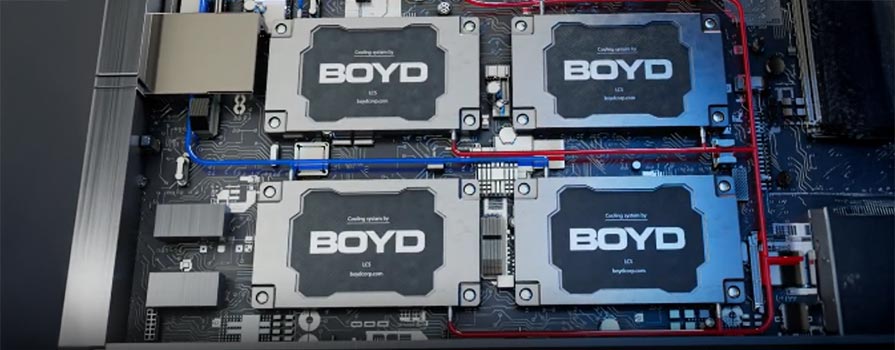Water and water/glycol solutions are common heat transfer fluids used in cooling systems and recirculating chillers. Although the fluids are the lifeblood for your heat transfer applications, they can also cause corrosion within your systems.
Preventing Corrosion in Liquid Cooling Systems
Protecting your System from Leaks and Performance Degradation
This corrosion can result in a reduction in system thermal performance due to scaling on the heat transfer surface, decreased flow due to reduced pipe diameters from corrosion deposits, and ultimately the need for system component replacement due to corrosion damage.
Corrosion is the chemical or electrochemical reaction between materials, usually a metal and its environment, which results in deterioration of the metal and its properties. This article will cover chemical corrosion. (For more information on electrochemical or galvanic corrosion, please see our application note “Avoiding Galvanic Corrosion.”) Corrosion of metallic components is an inherent problem for water and water/glycol cooling systems because many metals naturally tend to oxidize in the presence of water. The dissolved oxygen in water accelerates most corrosion processes. In closed loop systems, dissolved oxygen is consumed over time and no longer poses a corrosion risk. For open loop systems, however, continued exposure to air allows oxygen to dissolve into the coolant. Therefore, open loop systems often suffer more corrosion problems compared to closed units.
Corrosion is usually classified as either general or localized. General corrosion is the loss of metal uniformly distributed over an entire surface. It typically does not lead to rapid system failure because the rate of metal loss can be discovered before the metal ruptures. Localized corrosion, on the other hand, is not as predictable. It usually shows up in the form of pitting, which can penetrate the metal very quickly, forming cavities or holes. Another common form of localized corrosion is cavitation, which occurs when pockets of vapor form in a liquid. This process occurs when local pressure near the metal surface falls below the vapor pressure of the liquid. When these vapor bubbles collapse or implode, they generate large amounts of energy. This causes severe pitting to system components (such as pumps), generates a great deal of noise, and results in a decrease in pump efficiency.
Potential Corrosion Problems
Corrosion can lead to many problems, the most significant being perforation that may result in coolant leakage. Other problems may include reduced heat transfer caused by surface scaling, which occurs when metal reacts with oxygen, chloride, and/or inhibitors in the coolant and precipitates back to the metal surface, creating a layer that acts as a heat transfer barrier. Additionally, concerns include the clogging of particulate filters and damage to mechanical seals.
When copper corrodes, it is more often degraded by general corrosion than by pitting. General corrosion will often attack copper exposed to ammonia, oxygen, or fluids with high sulfur content. Another source of corrosion affecting copper is dissolved salt in the fluid, such as chlorides, sulfates, and bicarbonates.
For aluminum, pitting is the most common form of corrosion. Pitting is usually produced by the presence of halide ions, of which chloride (Cl-) is the most frequently encountered in liquid cooling loops. Pitting of aluminum in halide solutions open to air occurs because, in the presence of oxygen, the metal is readily polarized to its pitting potential and the naturally occurring protective oxide layer or film is penetrated. This film is stable in aqueous solutions when pH is between about 4.0 and 8.5. The film is naturally self-renewing and accidental abrasion or other mechanical damage of the surface oxide film is rapidly repaired. Boyd strongly recommends an inhibitor when using water with aluminum to maintain a clean heat transfer surface.
Stainless steel is typically used in corrosive environments but, as with aluminum, it is sensitive to high concentrations of chlorides (>100 ppm) in an oxidizing environment. Pitting remains among the most common and damaging forms of corrosion in stainless steel alloys, but it can be prevented by ensuring that the material is exposed to oxygen and protected from chloride wherever possible. Stainless steels high in chromium, and particularly molybdenum and nitrogen, are more resistant to pitting corrosion.
Corrosion Caused by Uninhibited Ethylene Glycol
Studies show that uninhibited ethylene glycol will degrade into five organic acids – glycolic, glyoxylic, formic, carbonic, and oxalic – in the presence of heat, oxygen, and common cooling system metals such as copper and aluminum. Copper and aluminum act as a catalyst in the presence of uninhibited ethylene glycol. These organic acids will then chemically attack copper and aluminum in as little as three weeks under extreme conditions (212°F and oxygen bubbling into the uninhibited ethylene glycol solution) to form metal organic compounds in the fluid, which can lead to clogging of pipes, pumps, valves, etc.
Literature references often state that copper and aluminum are compatible with uninhibited ethylene glycol, but usually those recommendations are based on a two-week chemical compatibility study of various metals at different temperatures. The study above indicates that uninhibited ethylene glycol typically does not begin to degrade until after three weeks under those extreme conditions. In conclusion, the reported data is based on ethylene glycol’s ability to dissolve the metal and ignores the concern of degraded, acidic uninhibited ethylene glycol and its effects on metals. The latter is much more corrosive towards metals.
Protecting Against Corrosion
In general, corrosion can be reduced through pH control and corrosion inhibitor use. The inhibitors attach to metal surfaces to passivate them and prevent corrosion. It is also important to maintain a stable water flow to avoid stagnant zones inside the cooling system, which can cause corrosion.
Quality of water also needs to be considered when trying to prevent corrosion. The corrosive effect of natural water can vary considerably depending on its chemical composition. As mentioned earlier in this article, chloride is corrosive and use of tap water should be minimized or avoided if it contains more than 100 ppm of chloride. Hardness of water also needs to be considered because it introduces calcium and magnesium, which form scale on the metal surfaces. Deionized water, demineralized water, or water that has been passed through a reverse osmosis process to remove harmful minerals and salts is highly recommended in order to avoid chloride and scale buildup. A suitable corrosion inhibitor must be used with deionized or demineralized water.
There are different inhibitors for use with different metals, each with its advantages and disadvantages.
- Phosphate is an effective corrosion inhibitor for iron, steel, lead/tin solder, and most aluminum components. It is also a very good buffer for pH control. One disadvantage of phosphate is precipitation with calcium in hard water, which is one reason that deionized water is used for diluting a glycol/water coolant.
- Tolyltriazole is a common and highly effective corrosion inhibitor for copper and brass.
- Mercaptobenzothiazole also works for copper and brass, but it is not as stable as tolyltriazole.
- Nitrite is an excellent corrosion inhibitor for iron. At high concentrations, this inhibitor is corrosive to lead/tin solder.
- Silicate is an effective inhibitor for most metals but tends to form thick deposits in cooling systems. The rust inhibitors in automotive anti-freeze may cause premature failure of pump seals. Chromate and soluble oils have been used in the past, but their use has greatly diminished due to toxicity. Modern inhibitors have replaced them.
Liquid Cooling System Erosion-Corrosion
Ensuring Longer Lifetimes by Managing Erosion-Corrosion
Heat exchangers and cold plates are used in cooling applications to remove and transfer heat from one place to another using a heat transfer fluid such as water, ethylene glycol and water solution, oil, etc. There are thousands of combinations of fluids and fluid path materials used in these applications. One of the main criteria for selecting the fluid path materials in these components should be the materials’ ability to resist corrosion. Corrosion comes in many different forms, including “erosion-corrosion”. It is important to know fluid properties as well as material properties in order to minimize erosion-corrosion and optimize system performance and life.
What is Erosion-Corrosion?
Erosion-corrosion is acceleration in the rate of corrosion in metal due to the relative motion of a fluid and a metal surface. It typically occurs in pipe bends & elbows, tube constrictions, and other structures that alter flow direction or velocity. The mechanism for this type of corrosion is the continuous flow of fluid, which removes any protective film or metal oxide from the metal surface. It can occur both in the presence and in the absence of suspended matter in the flow stream. In the presence of suspended matter, the effect is very similar to sandblasting, and even strong films can be removed at relatively low fluid velocities. Once the metal surface is exposed, it is attacked by the corrosive media and eroded away by fluid friction. If the passive layer of metal oxide cannot be regenerated quickly enough, significant damage may occur.
Some materials are more resistant than others to erosion-corrosion under the same fluid conditions. Erosion-corrosion is most prevalent in soft alloys, such as copper and aluminum. Although increasing the flow rate of the fluid in your cooling application may increase its performance, it may also increase erosion-corrosion. Therefore, it is important to determine how great an impact increasing the flow rate will have on your thermal performance, as you may see minimal improvement in performance with a significant drop in the longevity of your heat exchanger or cold plate.
The following graph shows the effects of fluid velocity on performance and erosion on a 3/8″ copper tube-fin liquid-to-air heat exchanger. The graph shows that in the turbulent region of flow (Re > 4000) and at volumetric flow rates of less than 2 gpm, water velocities are within the recommended values of less than 8 ft/sec (2 gpm) for copper tubing (see Table 1). Given the same diameter tubing, doubling the flow rate in the turbulent region of flow doesn’t result in double the thermal performance. However, doubling the flow rate in the laminar and transitional regions can more than double the heat exchangers performance.
Table 1
| Water | Maximum Recommended Water Velocities |
|---|---|
| Low Carbon Steel | 10 ft/sec |
| Stainless Steel | 15 ft/sec |
| Aluminum | 6 ft/sec |
| Copper | 8 ft/sec |
| 90-10 Cupronickel | 10/ ft/sec |
| 70-30 Cupronickel | 15 ft/sec |
Controlling Erosion-Corrosion
Some methods for minimizing erosion-corrosion include improving the flow lines within the pipe by deburring (i.e. – smoothing out irregularities), allowing bends to have larger angles, and changing pipe diameters gradually rather than abruptly. Other methods include slowing the flow rate (minimizing turbulence), reducing the amount of dissolved oxygen, changing the pH, and switching the pipe material to a different metal or alloy.
In addition to the fluid path material used, it is also important to consider your fluid’s temperature. At higher temperatures, flow rates should be lowered to minimize erosion-corrosion. For example, as a general rule, water flow velocities should not exceed 8 ft/sec for cold water and 5 ft/sec for hot water (up to approximately 140 °F). In systems where water temperatures routinely exceed 140 °F, flow velocities should not exceed 3 ft/sec. For maximum recommended water velocities in other typical tube materials, refer to Table 1. For other fluids, the maximum allowable fluid velocity can be calculated from:
Allowable velocity for given fluid] = [Allowable velocity for water] x [Density of water/density of given liquid] 1/2.
There will always be a trade-off between thermal performance and reliability/longevity in any cooling system. Increasing fluid flow will give you more cooling or performance only up to a point. After that, increased fluid velocities may rapidly begin to erode and corrode the inside metal surface of the tubing. Designers should consider many different factors, such as the ones discussed above, in order to determine the best solution for their application.
Avoiding Galvanic Corrosion
How Corrosion Occurs in Liquid Cooling Loops
When selecting components for your liquid cooling loop, you must consider their material compatibility as well as individual performance. Although an aluminum-tubed cold plate paired with a copper-tubed heat exchanger might meet your thermal requirements, it is not a reliable cooling circuit. Copper and aluminum have widely different electrochemical potentials, so when they are combined in a cooling system, galvanic corrosion is likely. Galvanic corrosion (also called dissimilar metal corrosion) erodes the metal, causing leaks over time.In a cooling loop, metallic materials in electrochemical contact can form a galvanic cell, or battery (fig. 1). In a galvanic cell, when two metals with different electrical potentials are connected, there is a potential difference across them. The metal with the higher electrical potential becomes the anode, and the lower, the cathode. A current will flow from the anode to the cathode. The anode dissolves, or corrodes, to form ions. These ions drift into the water where they either stay in solution or react with other ions in the electrolyte. This process is known as galvanic corrosion.
A galvanic cell requires three elements:
- Two electrochemically dissimilar metals
- An electrically conductive path between the two metals, and
- An electrolyte to allow the flow of metal ions.


The galvanic corrosion rate depends on the electrical potential between the two metals. The Galvanic Series (fig. 2) orders metals based on the potential they exhibit in flowing seawater. The most reactive are at the top of the table and the least reactive at the bottom.
Elevated temperatures, which are likely in cooling loops, accelerate galvanic corrosion. A 10°C increase in temperature can approximately double the corrosion rate. Corrosion inhibitors can be added to the cooling water.
This slows, but does not eliminate, galvanic corrosion. Corrosion inhibitors bind with the ions in solution to neutralize them. The inhibitors are consumed in this process so they need replacing regularly. Non-aqueous coolants, such as oils, eliminate galvanic corrosion because they do not support ions. However, thermal performance is sacrificed, as the thermal conductivities of heat transfer oils are generally significantly lower than water-based coolants.
To avoid galvanic corrosion, we highly recommend using the same materials, or materials with similar electrical potential, throughout your cooling loop. You should ensure that plumbing, connectors and other components do not introduce a reactive metal into the system.
Using the same materials throughout your circuit does not mean that you must sacrifice performance. Boyd offers high performance heat exchangers and cold plates with aluminum, copper and stainless steel fluid paths.
Boyd’s application engineers are available to consult on component material compatibility. With careful design and component selection, you can ensure years of reliable, corrosion free service from your cooling loop.
Aluminum Corrosion Resistance for Liquid Cold Plates and Plate-Fin Heat Exchangers
When selecting components for your liquid cooling loop, you must consider their material compatibility as well as individual performance. Although an aluminum-tubed cold plate paired with a copper-tubed heat exchanger might meet your thermal requirements, it is not a reliable cooling circuit. Copper and aluminum have widely different electrochemical potentials, so when they are combined in a cooling system, galvanic corrosion is likely. Galvanic corrosion (also called dissimilar metal corrosion) erodes the metal, causing leaks over time.
Corrosion of Aluminum in Liquid Cold Plates
Aluminum is known for its corrosion resistance. Under the right conditions, aluminum rapidly forms a protective oxide layer. Generally, this occurs when oxygen is readily available and the surrounding medium has a moderate pH. There are two typical manifestations of aluminum corrosion: uniform corrosion and local corrosion. Uniform corrosion happens when the oxide layer is soluble in the corrosive medium. “The oxide film is soluble in alkaline solutions and in strong acids…but is stable over a pH range of approximately 4.0 – 9.0.” In uniform corrosion, the entire oxide layer is being stripped away faster than it can reform. Local corrosion, usually in the form of a pit, occurs when there is non-uniformity in the base metal or the surrounding environment. The metal may have a local concentration of alloying elements that creates a galvanic couple. Similarly, the surrounding environment may have a local concentration of active elements such as chlorides.
Liquid cold plates and heat exchangers are used with many different fluids and typically involve the recirculation of the same fluid. One fluid that should not be used in aluminum cold plates and heat exchangers is water. Tap water can contain active ions, such as copper, bicarbonates, chlorides, and/or other impurities that facilitate corrosion. Plus, the recirculation of the same fluid over time in a closed loop will cause the dissolved oxygen to come out of the solution. The resulting lack of oxygen will inhibit the formation of the oxide layer. Given enough time, aluminum will eventually corrode if isolated from oxygen and exposed to low quality water.
When water is the preferred choice for a heat transfer system, distilled water is usually combined with a glycol to reduce its freezing point and increase its boiling point. For the reasons stated above, it is critical that corrosion inhibitors be used. Corrosion inhibitors are controlled amounts of active ions (usually phosphates) that take over the role of oxygen in forming a corrosion resistant layer. Since these inhibitors depend on a chemical reaction with the aluminum, using low quality water such as tap water would reduce the inhibitors’ effectiveness.
Designing for Corrosion Resistance
Alloy selection is a key factor in high corrosion resistance. For example, braze sheets, which separate the fluid passages in plate-fin heat exchangers, consist of an internal core and external clad layer that usually represents about 10% of the overall sheet thickness. The clad layer is a brazing alloy that joins the braze sheet to both the hot and cold fins and the braze sheet to the side bars. Vacuum brazing alloys use silicone and other elements to lower the melting point of the alloy. Since the braze alloy is more anodic than the core, the braze alloy provides cathodic protection, and thus corrosion protection.
Cathodic protection is a concept that has been used in the ship building business for decades. For hulls made of steel, a plug made of an active element, like zinc, is used to protect the hull. Because zinc is more active than steel, the zinc corrodes faster that the steel. Among the alloying elements of aluminum, the alloys with a minimum of copper and iron have the best corrosion resistance. “3xxx series alloys are generally among those having the highest general corrosion resistance…The 6xxx alloys also have high resistance.”
There are other considerations in cold plate and heat exchanger design. Internal fluid static pressure and external stresses put the core components under stress. These stresses often require that high strength alloys (6xxx series) be used for braze sheets and/or fins. Braze sheet thickness is a tradeoff between performance, weight, and corrosion protection. A thick braze sheet is heavy and reduces thermal performance. A thin braze sheet has less strength to withstand stresses and offers less corrosion protection. If a corrosive environment is present, thin braze sheets will withstand an attack for less time than a thicker sheet.
Cold Plate and Heat Exchanger Leak Testing
During their manufacturing process, cold plates and heat exchangers may be hydraulically tested with pure water. However, water should not remain in the unit longer than is needed to conduct the testing. A thorough drying process is critical to eliminate the possibility of water corrosion. “Bubble testing,” or pressurizing a unit with a gas and submerging it in water, is used widely throughout the industry. This practice requires that the external surfaces be dried after testing. Learn More about Boyd testing services and procedures.
Liquid Cold Plate and Heat Exchanger Operation
When operating a water/glycol cold plate or heat exchanger, it is important to have a maintenance plan. The typical maintenance activity is flushing and refilling the system with the proper mixture of inhibited ethylene glycol and water. This should be done on a periodic basis at an interval determined through system level testing during the operational evaluation phase. Periodically, the fluid pH and refractive index should be measured. These measurements will change over time. From these measurements, a flushing frequency could be determined.
During deployment, it is common for coolant systems to be “topped off”. This practice should not harm the cold plate or heat exchanger as long as the glycol concentration is not diluted to the point of making the inhibitor ineffective. Inhibitor effectiveness is a function of top-off water quality, other metal types in the fluid loop, and the age of inhibitor in the system. If “topping off” is employed, it is advisable to monitor the pH of the fluid. If the pH falls below 4.0 or rises above 9.0, a system flush/fill should take place as soon as possible.
Corrosion resistance begins with cold plate or heat exchanger design. It is also important to develop maintenance procedures that will maximize the life of the aluminum cold plate or heat exchanger.
Corrosion Prevention Summary
Although we can’t stop corrosion all together, there are ways to significantly limit it. By selecting proper fluid path materials, monitoring solution chemistry (specifically pH levels and water quality), and choosing appropriate inhibitors, you can minimize the cost impact due to corrosion and ensure the effective operation of your liquid cooling loop for years.







